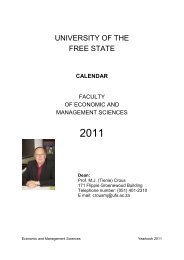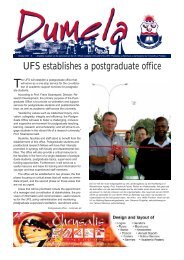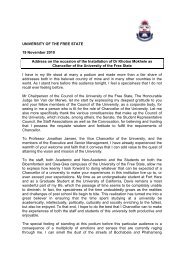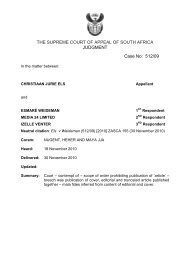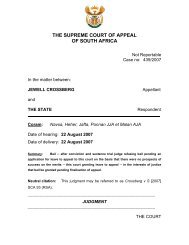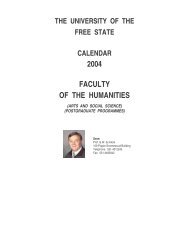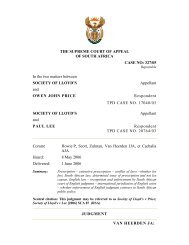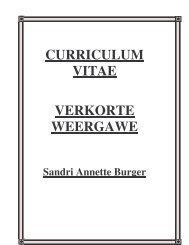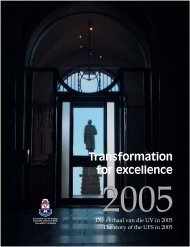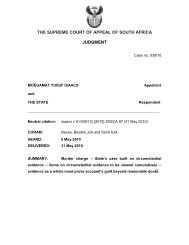inhoud - University of the Free State
inhoud - University of the Free State
inhoud - University of the Free State
Create successful ePaper yourself
Turn your PDF publications into a flip-book with our unique Google optimized e-Paper software.
accountability<br />
in higher education<br />
We do a poor job<br />
at communicating<br />
our achievements,<br />
Pr<strong>of</strong>. Magda Fourie,<br />
Vice-rector:<br />
Academic Planning<br />
at <strong>the</strong> <strong>University</strong> <strong>of</strong><br />
<strong>the</strong> <strong>Free</strong> <strong>State</strong>, said<br />
in her inaugural<br />
lecture.<br />
Pr<strong>of</strong>. Fourie outlined <strong>the</strong> higher<br />
education landscape in South Africa and<br />
compared it also with market-driven independent<br />
institutions, like those in <strong>the</strong><br />
United <strong>State</strong>s <strong>of</strong> America, and state-controlled<br />
institutions, like those in Europe.<br />
In Africa universities have traditionally<br />
had relatively low levels <strong>of</strong> autonomy, and<br />
governmental involvement in university<br />
affairs was <strong>the</strong> norm.<br />
The higher education system in apar<strong>the</strong>id<br />
South Africa was a highly fragmented<br />
and unequal one – to such an extent that<br />
it hardly merited being called a “system”,<br />
she said. Before 1994 <strong>the</strong> almost unfettered<br />
autonomy <strong>of</strong> <strong>the</strong> historically white uni-<br />
versities was counterbalanced by <strong>the</strong> tight<br />
regulation and control <strong>of</strong> government<br />
over universities for Blacks, Coloureds<br />
and Indians.<br />
“From this history <strong>of</strong> a racially and<br />
ethnically divided, inequitable, administratively<br />
fragmented and intellectually isolated<br />
higher education system with highly<br />
uneven measures <strong>of</strong> autonomy and accountability,<br />
<strong>the</strong> new democratic government<br />
had to forge <strong>the</strong> ideal <strong>of</strong> a single<br />
coordinated higher education system,<br />
serving <strong>the</strong> twin ideals <strong>of</strong> equity and<br />
excellence in a developing country within<br />
a global knowledge economy.<br />
“The relationship between higher<br />
education and <strong>the</strong> state is always a contested<br />
one. No country in <strong>the</strong> world can<br />
escape from <strong>the</strong> tension that exists between<br />
a desirable (and necessary) degree<br />
<strong>of</strong> institutional autonomy and academic<br />
freedom versus <strong>the</strong> legitimate rights <strong>of</strong><br />
governments to generate a certain level <strong>of</strong><br />
control (accountability) over universities<br />
that are predominantly publicly financed,”<br />
she said.<br />
Pr<strong>of</strong>. Fourie believes that, in order to<br />
be both responsible and responsive, universities<br />
require government to guide<br />
change through:<br />
• A coherent policy framework: Proactive,<br />
meaningful reforms should be<br />
rooted in a clear long-term vision for<br />
higher education. This vision should<br />
include at least three dimensions:<br />
firstly, outlining how higher education<br />
can most effectively contribute<br />
towards national growth in <strong>the</strong><br />
context <strong>of</strong> a developing country in a<br />
globally articulated knowledge-based<br />
economy; secondly, agreeing on <strong>the</strong><br />
roles <strong>of</strong> different types <strong>of</strong> higher<br />
education institutions in <strong>the</strong> system,<br />
News<br />
and thirdly, determining <strong>the</strong><br />
conditions under which higher<br />
education can become more effective<br />
and efficient. It also implies policies<br />
and mechanisms that do not exist in<br />
disjuncture, but that articulate and<br />
support one ano<strong>the</strong>r.<br />
• An enabling regulatory environment:<br />
The second responsibility <strong>of</strong><br />
government is to create a regulatory<br />
environment that encourages ra<strong>the</strong>r<br />
than stifles innovation in higher<br />
education and initiatives by higher<br />
education institutions to engage in<br />
high quality, relevant teaching and<br />
research. Enabling regulation focuses<br />
on outcomes, leaving institutions to<br />
control inputs and processes. It<br />
should also be acknowledged that any<br />
regulatory framework has its<br />
limitations. Accountability efforts<br />
should be guided by <strong>the</strong> premise that<br />
some important elements <strong>of</strong> higher<br />
education practice cannot be<br />
measured reliably.<br />
• Appropriate financial incentives:<br />
Financial mechanisms and incentives<br />
to steer institutions towards quality,<br />
efficiency and equity goals include<br />
allocating formulae that link resources<br />
to institutional performance,<br />
encouragement <strong>of</strong> resource<br />
mobilisation by institutions,<br />
competitive funds for investments in<br />
quality improvement, and student<br />
financial aid. In addition, budgeting<br />
should not be so performance driven<br />
as to cause fiscal instability from one<br />
year to <strong>the</strong> next – as we are<br />
experiencing at <strong>the</strong> moment. And<br />
importantly, higher priority should be<br />
ascribed to academic quality than to<br />
cost containment and efficiency.<br />
Bult<br />
13



